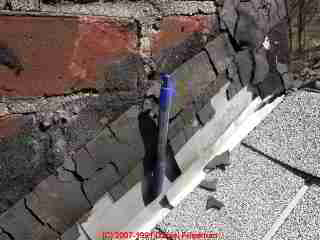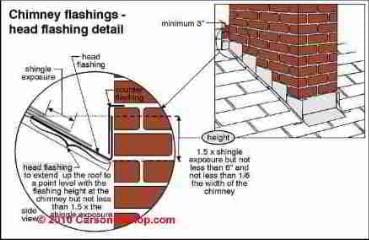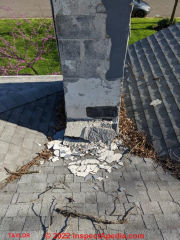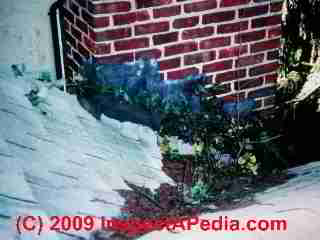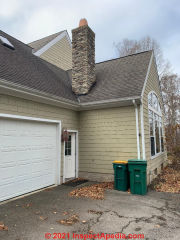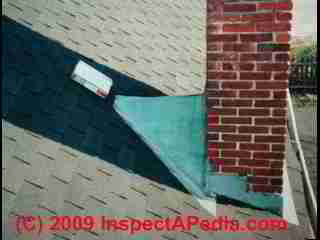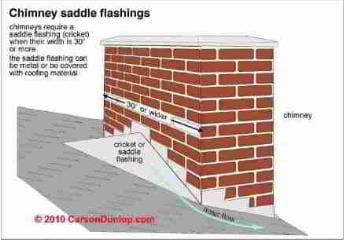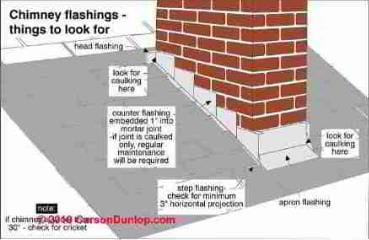 Chimney Flashing
Chimney Flashing
Chimney Flashing
Leak Diagnosis by Rooftop Inspection
- POST a QUESTION or COMMENT about chimney flashing choices, installation, leaks & defects that are found by an on-roof inspection
Chimney flashing installation, choices & inspection from the rooftop for leaks or installation errors.
This article describes chimney inspection on the roof, reporting on flashing and leak problems, and inspecting and diagnosing cracks in the sides of a brick chimney. Page top sketch of chimney flashing defect checkpoints provided courtesy of Carson Dunlop Associates, a Toronto home inspection, education & report writing tool company [ carsondunlop.com ].
This article series on chimneys, chimney construction, and chimney safety provides detailed suggestions describing how to perform a thorough visual inspection of chimneys for safety and other defects. Chimney inspection methods and chimney repair methods are also discussed.
InspectAPedia tolerates no conflicts of Interest. We have no relationship with advertisers, products, or services discussed at this website.
- Daniel Friedman, Publisher/Editor/Author - See WHO ARE WE?
Chimney Flashing Mistakes & Chimney Leaks, Damage
Article Series Contents
- CHIMNEY STEP FLASHING ERRORS
- CHIMNEY CRICKET / SADDLE NEEDED on SOME ROOFS
- CHIMNEY CRICKET CONSTRUCTION DETAILS
- METAL CHIMNEY FLASHING & STORM COLLARS - separate article
Page top photo: example of missing counterflashing at a brick chimney and a futile effort to seal that juncture with flashing cement - details are below.
[Click to enlarge any image]
Chimney Step Flashing Leaks
Horrible chimney flashing at the roof surface is shown in these photos which are remarkable for the number of errors, the leak history at this home, and the chances of related damage to the surrounding wood structure from insects or rot, or damage to the chimney itself from frost.
The new roof was installed with a bare half-inch of vertical side flashing along the chimney and no counter flashing. The previous roof or chimney flashing was installed with no counter flashing, relying on roofing mastic to seal this juncture. Cracks and openings at chimney flashing admit wind-blown rain into the structure.
An inspector with binocular vision might have found this crazy flashing installation from the ground. Maybe.
[Click to enlarge any image]
Watch out: older asphalt-based roofing mastics and sealants may contain asbestos.
See MASTIC, CUTBACK ADHESIVE, FLASHING CEMENT ASBESTOS.
The illustrations above & below, courtesy of Carson Dunlop Associates, show chimney flashing details when there is NOT a chimney saddle or cricket as well as where some of the trouble spots occur.
...
Chimney Saddle or Chimney Cricket Flashing Can Prevent Roof Leaks
Above: a chimney located in a roof valley obstructs roof drainage, invites roof leaks, and ultimately chimney damage that can make the chimney unsafe, risking a building fire or fatal carbon monoxide poisoning.
Where chimneys are broad in width (30 inches or more) or located too close to a valley or other obstruction (photos above), the raised ridged structure shown in Carson Dunlop Associates [at REVIEWERS] sketch (above left), alternately called a chimney cricket or a chimney saddle (illustrated below), can significantly reduce debris collection at the chimney-roof intersection on the up-slope side of the chimney as well as reducing the chances of leaks at this otherwise common roof leak point.
Our photo and Carson Dunlop's sketch above show a typical chimney saddle or cricket, installed.
Don't walk on this structure. Some chimney saddles or crickets are supported only sufficiently to shed water but not for foot traffic.
When inspecting the chimney for leaks look closely at the chimney cricket or chimney saddle for metal fatigue cracks or other damage.
Additional details about roof flashing inspection, defects, and repair are
...
Suggested Details for Roof Saddle / Chimney Cricket Construction
Question: How about some details on roof saddle construction?
[Paraphrasing: On a messy re-roof job that includes a roof section with lots of penetrations, we are cleaning up the roof design to reduce the leak risk by constructing a roof saddle or cricket.]
I see reference to "crickets" all over... your site mentions them on "Flashing & Sealing Specifications for Exposed Fastener Metal Roof Systems" page. But I have been unable to find specific instruction... models, diagrams etc., on how to build these things. What I do see around here is a lot of metal roofs.
The roofs I've checked out with the same issues that I'm asking about (vertical wall on downside slope of a roof) all were done without crickets. And every winter, I see a bucket of Henry's tar up there trying to patch the leaks. So if you have a reference for building crickets or a good book I'd sure appreciate it. -- Jim McKay, November 2010
Reply: Build a Tiny Intersecting Roof Gable, Standard Chimney Step & Counter Flashing, Valley Flashing, careful sealing
We hadn't previously thought about giving specific build instructions for a chimney cricket or roof saddle, perhaps because building a saddle is a duplication of the framing for roof construction of a tiny intersecting gable - standard carpentry.
As you'll see in our photos of chimney saddles above, the cricket or saddle will form an intersecting gable that butts against the up-roof side of the chimney.The devil is once again, in the details of forming and sealing flashing to avoid leaks from water or in some climates melting snow on the up-roof side of the chimney. A chimney saddle also avoids the accumulation of debris, leaves, etc. that shorten roof life in that area.
The length of the ridge of your cricket (or saddle) will determine the height of the cricket at the chimney and the point at which that ridge contacts the main roof slope. We make sure that the cricket ridge is long enough that the height above the roof at the chimney is high enough that we have a decent slope, 6 in 12 or more, to assure good drainage around the chimney.
Of course the total length of the saddle ridge is limited if you don't have a lot of roof distance up-slope from the chimney itself. In that case the ridge of the cricket will come to the ridge of the main roof. And of course your cricket (saddle) ridge is framed level.
If the total cricket size is small, just a few feet or less, it's probably easiest to simply construct the entire supporting structure for the cricket out of 1x lumber.
Larger crickets would be framed using 2x lumber and roof sheathing. Remember that maybe not you, but someone is likely to step on the cricket sooner or later, perhaps while repairing or cleaning the chimney. So flimsy saddles and crickets are a bad idea.
Once the chimney saddle has been built and nailed into place on the main roof slope, you can proceed to cover it with metal flashing, ice and water shield etc. and then a metal cover or roof shingles or another covering that matches what's on the main slope. Some roofers cover large crickets with shingles or roll roofing, but we prefer solid metal or a membrane such as modified bitumen.
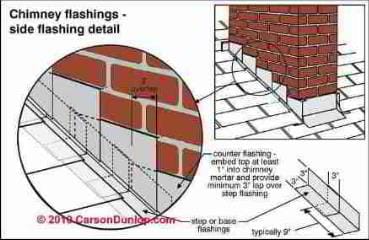
If you are using shingles on the cricket surface, flashing at the abutment of the cricket to the up-roof chimney side will be formed using step flashing (one per shingle) and typically a single piece of counter flashing for each side of the cricket.
[Click to enlarge any image]
Your flashing will need to extend no less than 4" up the chimney face, and be covered by counterflashing cut into (a "reglet) the chimney face and sealed.
When you are flashing the valleys formed by the cricket sides, follow normal valley flashing design details, being sure that the flashing is both built with a hooked edge, cleated 12" on center, and sealed to the shingles on the main roof so that water doesn't run down the cricket and under the roof shingles.
If you're covering the whole cricket with shingles, then the cricket ridge is shingled like a roof ridge, with the last ridge cap shingle where the cricket ridge meets the main roof slope done the same way as a lower roof ridge would meet a main upper slope - the last shingle has to be split, and sealed, before the shingle on the main roof slope course covers it up.
Make your flashing the feature that keeps water out of the roof. Don't rely on caulks and sealants.
...
Cracked Brick Masonry Chimney Sides
Thin Cracks in Brick or Masonry Block Chimneys
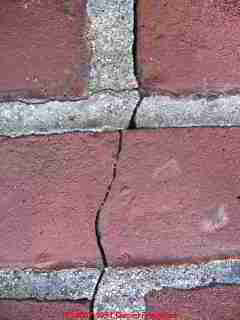

Cracked chimney masonry such as shown in this photo of cracks in a brick chimney exterior, may a safety concern if the flue liner or chimney are not intact and fire/gas safe.
Cracks in a brick masonry chimney such as shown in these photographs may be caused by improper original chimney construction. This damage also appears on concrete block constructed chimneys.
See CHIMNEY CRACK DETECTION & DIAGNOSIS for details about inspecting and diagnosing types of chimney cracks and movement.
WARNING: Cracks in a chimney can be very significant and dangerous, risking fire or chimney collapse. Be sure to review the articles
at BRICK CHIMNEY CRACKS & COLLAPSE.
Question: What should I do about ongoing flashing leaks at my stone chimney?
This topic has moved to STONE CHIMNEYS, FLASHING, LEAK REPAIR
Metal Flashing & Storm Collar for Round Metal Chimneys & Flues
...
Continue reading at FLASHING ROOF WALL DETAILS or select a topic from the closely-related articles below, or see the complete ARTICLE INDEX.
Or see these
Rekated Articles
- CHIMNEY CAP & CROWN DEFINITIONS the difference between a chimney rain cap and a chimney top seal - two different possible leak problems.
- CHIMNEY CHASE CONSTRUCTION
- CHIMNEY DAMAGE by LEAKS & FROST
- CHIMNEY INSPECTION at ROOFTOP
- CHIMNEY RAIN CAP / RAIN COVER INSPECTION
- CHIMNEY SHOULDER LEAKS
- CHIMNEY STAINS, INDOORS
- CHIMNEY STAINS & LEAKS
- CLAY TILE ROOF FLASHING LEAKS
- CRACKED CHIMNEYS, MASONRY BLOCK
- FLASHING, CHIMNEY MISTAKES & LEAKS
- FLASHING for METAL ROOFS
- FLASHING ROOF-WALL SNAFU
- FLASHING WALL DETAILS - Roof-wall, roof-chimney & siding bottom
- MASTIC, CUTBACK ADHESIVE, FLASHING CEMENT ASBESTOS
- METAL CHIMNEY FLASHING & STORM COLLARS
- STONE CHIMNEYS, FLASHING, LEAK REPAIR
Suggested citation for this web page
FLASHING, CHIMNEY MISTAKES & LEAKS at InspectApedia.com - online encyclopedia of building & environmental inspection, testing, diagnosis, repair, & problem prevention advice.
Or see this
INDEX to RELATED ARTICLES: ARTICLE INDEX to CHIMNEYS & FLUES
Or use the SEARCH BOX found below to Ask a Question or Search InspectApedia
Ask a Question or Search InspectApedia
Questions & answers or comments about chimney flashing leaks & defects that are found by an on-roof inspection.
Try the search box just below, or if you prefer, post a question or comment in the Comments box below and we will respond promptly.
Search the InspectApedia website
Note: appearance of your Comment below may be delayed: if your comment contains an image, photograph, web link, or text that looks to the software as if it might be a web link, your posting will appear after it has been approved by a moderator. Apologies for the delay.
Only one image can be added per comment but you can post as many comments, and therefore images, as you like.
You will not receive a notification when a response to your question has been posted.
Please bookmark this page to make it easy for you to check back for our response.
IF above you see " Comment Form is loading comments..." then COMMENT BOX - countable.ca / bawkbox.com IS NOT WORKING.
In any case you are welcome to send an email directly to us at InspectApedia.com at editor@inspectApedia.com
We'll reply to you directly. Please help us help you by noting, in your email, the URL of the InspectApedia page where you wanted to comment.
Citations & References
In addition to any citations in the article above, a full list is available on request.
- Mark Cramer Inspection Services Mark Cramer, Tampa Florida, Mr. Cramer is a past president of ASHI, the American Society of Home Inspectors and is a Florida home inspector and home inspection educator. Mr. Cramer serves on the ASHI Home Inspection Standards. Contact Mark Cramer at: 727-595-4211 mark@BestTampaInspector.com
- Roger Hankeyis principal of Hankey and Brown home inspectors, Eden Prairie, MN, technical review by Roger Hankey, prior chairman, Standards Committee, American Society of Home Inspectors - ASHI. 952 829-0044 - hankeyandbrown.com
- Thanks to reader & roofer Jim McKay, for discussion of roof cricket or saddle construction, 11/2010
- NFPA 211 - Standards for Chimneys & Fireplaces, NFPA 211: Standard for Chimneys, Fireplaces, Vents, and Solid Fuel-Burning Appliances, 2006 Edition (older editions and standards are found at the same bookstore)
- NFPA #211-3.1 1988 - Specific to chimneys, fireplaces, vents and solid fuel burning appliances.
- NFPA # 54-7.1 1992 - Specific to venting of equipment with fan-assisted combustion systems.
- GAMA - Gas Appliance Manufacturers' Association has prepared venting tables for Category I draft hood equipped central furnaces as well as fan-assisted combustion system central furnaces.
- National Fuel Gas Code, an American National Standard, 4th ed. 1988 (newer edition is available) Secretariats, American Gas Association (AGA), 1515 Wilson Blvd., Arlington VA22209, and National Fire Protection Association (NFPA), Batterymarch Park, Quincy MA 02269. ANSI Z223.1-1988 - NFPA 54-1988. WARNING: be sure to check clearances and other safety guidelines in the latest edition of these standards.
- Fire Inspector Guidebook, A Correlation of Fire Safety Requirements Contained in the 1987 BOCA National Codes, (newer edition available), Building Officials and Code Administrators International, Inc. (BOCA), Country Club HIlls, IL 60478 312-799-2300 4th ed. Note: this document is reissued every four years. Be sure to obtain the latest edition.
- Uniform Mechanical Code - UMC 1991, Sec 913 (a.) Masonry Chimneys, refers to Chapters 23, 29, and 37 of the Building Code.
- New York 1984 Uniform Fire Prevention and Building Code, Article 10, Heating, Ventilating, and Air Conditioning Requirements
- New York 1979 Uniform Fire Prevention & Building Code, The "requirement" for 8" of solid masonry OR for use of a flue liner was listed in the One and Two Family Dwelling Code for New York, in 1979, in Chapter 9, Chimneys and Fireplaces, New York 1979 Building and Fire Prevention Code:
- "Top Ten Chimney (and related) Problems Encountered by One Chimney Sweep," Hudson Valley ASHI education seminar, 3 January 2000, contributed by Bob Hansen, ASHI
- Chimney Inspection Checklist, Carson Dunlop, Associates, Toronto, Ontario
- "Rooftop View Turns to Darkness," Martine Costello, Josh Kovner, New Haven Register, 12 May 1992 p. 11: Catherine Murphy was sunning on a building roof when a chimney collapsed; she fell into and was trapped inside the chimney until rescued by emergency workers.
- "Chimneys and Vents," Mark J. Reinmiller, P.E., ASHI Technical Journal, Vol. 1 No. 2 July 1991 p. 34-38.
- "Chimney Inspection Procedures & Codes," Donald V. Cohen was to be published in the first volume of the 1994 ASHI Technical Journal by D. Friedman, then editor/publisher of that publication. The production of the ASHI Technical Journal and future editions was cancelled by ASHI President Patrick Porzio. Some of the content of Mr. Cohen's original submission has been included in this more complete chimney inspection article: CHIMNEY INSPECTION DIAGNOSIS REPAIR . Copies of earlier editions of the ASHI Technical Journal are available from ASHI, the American Society of Home Inspectors.
- Natural Gas Weekly Update: http://tonto.eia.doe.gov/oog/info/ngw/ngupdate.asp Official Energy Statistics from the U.S. Government
- US Energy Administration: Electrical Energy Costs http://www.eia.doe.gov/fuelelectric.html
- New Roof Construction Manual, [large PDF], Cedar Shake & Shingle Bureau, web search 11/15/2010, original source: http://www.cedarbureau.org/installation/roof_manual/pdfs/roof-manual.pdf.
US Address: PO Box 1178, Sumas, WA 98295-1178; Canadian Address: #2 – 7101 Horne St., Mission, BC V2V 7A2, TEL: 604-820-7700, www.cedarbureau.org, info@cedarbureau.com
Quoting:
This manual shows Cedar Shake & Shingle Bureau recommended procedures as of the manual’s print date. It is advisable to contact the Cedar Shake & Shingle Bureau to ensure that you are using the latest available information. - Our recommended books about building & mechanical systems design, inspection, problem diagnosis, and repair, and about indoor environment and IAQ testing, diagnosis, and cleanup are at the InspectAPedia Bookstore. Also see our Book Reviews - InspectAPedia.
- Ceramic Roofware, Hans Van Lemmen, Shire Library, 2008, ISBN-13: 978-0747805694 - Brick chimneys, chimney-pots and roof and ridge tiles have been a feature of the roofs of a wide range of buildings since the late Middle Ages. In the first instance this ceramic roofware was functional - to make the roof weatherproof and to provide an outlet for smoke - but it could also be very decorative.
The practical and ornamental aspects of ceramic roofware can still be seen throughout Britain, particularly on buildings of the Victorian and Edwardian periods. Not only do these often have ornate chimneys and roof tiles but they may also feature ornamental sculptures or highly decorative gable ends. This book charts the history of ceramic roofware from the Middle Ages to the present day, highlighting both practical and decorative applications, and giving information about manufacturers and on the styles and techniques of production and decoration.
Hans van Lemmen is an established author on the history of tiles and has lectured on the subject in Britain and elsewhere. He is founder member and presently publications editor of the British Tiles and Architectural Ceramics Society. - Chimney Inspection Checklist, Carson Dunlop, Associates, Toronto, Ontario
- Chimney & Stack Inspection Guidelines, American Society of Civil Engineers, 2003 - These guidelines address the inspection of chimneys and stacks. Each guideline assists owners in determining what level of inspection is appropriate to a particular chimney and provides common criteria so that all parties involved have a clear understanding of the scope of the inspection and the end product required. Each chimney or stack is a unique structure, subject to both aggressive operating and natural environments, and degradation over time. Such degradation may be managed via a prudent inspection program followed by maintenance work on any equipment or structure determined to be in need of attention. Sample inspection report specifications, sample field inspection data forms, and an example of a developed plan of a concrete chimney are included in the guidelines. This book provides a valuable guidance tool for chimney and stack inspections and also offers a set of references for these particular inspections.
- Fireplaces, a Practical Design Guide, Jane Gitlin
- Fireplaces, Friend or Foe, Robert D. Mayo
- NFPA 211 - Standards for Chimneys & Fireplaces, NFPA 211: Standard for Chimneys, Fireplaces, Vents, and Solid Fuel-Burning Appliances, 2006 Edition (older editions and standards are found at the same bookstore)
- Principles of Home Inspection: Chimneys & Wood Heating, in (Principles of Home Inspection), Carson Dunlop, Associates, Toronto, Ontario
- NFPA 211 - 3-1.10 - Relining guide for chimneys
- NFPA 211 - 3-2 - Construction of Masonry Chimneys
- NFPA 211 - 3-3 - Termination Height for chimneys
- NFPA 211 - 3-4 - Clearance from Combustible Material
- NFPA 54 - 7-1 - Venting of Equipment into chimneys
- Brick Institute of America - Flashing Chimneys
Brick Institute of America - Proper Chimney Crowns
Brick Institute of America - Moisture Resistance of Brick - American Gas Association - New Vent Sizing Tables
- Chimney Safety Institute of America - Chimney Fires: Causes, Effects, Evaluation
- National Chimney Sweep Guild - Yellow Pages of Suppliers
- In addition to citations & references found in this article, see the research citations given at the end of the related articles found at our suggested
CONTINUE READING or RECOMMENDED ARTICLES.
- Carson, Dunlop & Associates Ltd., 120 Carlton Street Suite 407, Toronto ON M5A 4K2. Tel: (416) 964-9415 1-800-268-7070 Email: info@carsondunlop.com. Alan Carson is a past president of ASHI, the American Society of Home Inspectors.
Thanks to Alan Carson and Bob Dunlop, for permission for InspectApedia to use text excerpts from The HOME REFERENCE BOOK - the Encyclopedia of Homes and to use I llustrations from The I LLUSTRATED HOME .
Carson Dunlop Associates provides extensive home Inspection education and report writing material. In gratitude we provide links to tsome Carson Dunlop Associates products and services.


